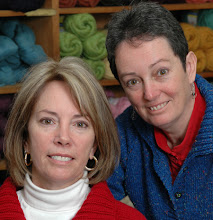I've been fascinated by making my knitting swirl. You can make a pattern rotate around a hat, socks, wristers, a bag or anything knit in the round. This is how it works.
1. There's a decrease with a matching increase so that the stitch numbers stay the same.
2. The swirl goes to the right or left or depending on where you put the decreases and which way they lean.
A decrease ("/") which leans to the right (K2tog) with an increase ("-") worked after a knit stitch (like a Kf&b: knit into front and back of same stitch) which moves the knit stitch ("V") to the Right looks just like this on your needle:
-V /
-V /
-V /
Now you have a design moving to the right. In this hat the Swirl Round was worked every second round with a knit round in between to facilitate working the garter stitch pattern. The angle of swirl is a little more vertical.
Swirling in the other direction?
Make an increase before the knit stitch and it moves the knit stitch to the left (although once again a Kf&b seems to work fine). The corresponding decrease should lean to the Left (SSK) as well.
\ V-
\ V-
\ V-
A new design swirling to the left. This sock has the Swirl Round worked every round which makes the angle of the swirl more pronounced. The increases and decreases pull the fabric in so about 10% more stitches are needed before beginning the swirl.
How do you get started? Divide your stitches into sections (as many as you like) and place markers so that each section has the same number of stitches in it. The same sequence is worked in each section.
How to Set-Up the Markers? The Right swirling pattern is easier to work with the Kf/b increase and a K2tog. I would set it up visually between Markers as:
* / ...... -V * (it looks like this on your needle)
written as: *Kf&b, knit to last 2 sts, K2tog; repeat in every section.
The pattern may not seem as obvious when you set it up with the Markers. Having the K2tog at the end of a section means the decreases will gobble up the stitches to the right where you have lots sitting there. The pattern becomes clearer as you work. The swirl itself is underlined here and straddles the Marker.
* / ..... -
V * / ..... -
V * / ..... -V *
Where can you fit in a stitch pattern? Making your stitch pattern dance in a circle is lots of fun.
*/ ..... -V, stitch pattern*
written as : * work stitch pattern, Kf&b, knit to last 2 sts, K2tog; repeat in each section.
- 4 sections with DK weight yarn and garter stitch pattern.
- 6 sections in Chunky weight wool
For the crown, continue to work stitch pattern and decreases only (no more increases).
OR how about putting the stitch pattern here?
*/ stitch pattern, -V*
The swirl decreases cut across the stitch pattern. This was really interesting to work. You have to incorporate the increases into the stitch pattern as you work but the affect is really great.
I included a free SWIRL DIY Hat Recipe in our latest Cabin Fever Newsletter. Email:
cabinfever.ca@gmail.com if you want a copy sent to you. Have fun swirling.
- Deb
Cabin Fever Ravelry Group

.jpg)
.jpg)
.jpg)
.jpg)
.jpg)
.jpg)
.jpg)
.jpg)
.jpg)
.jpg)
.jpg)
.jpg)
.jpg)



